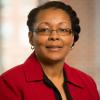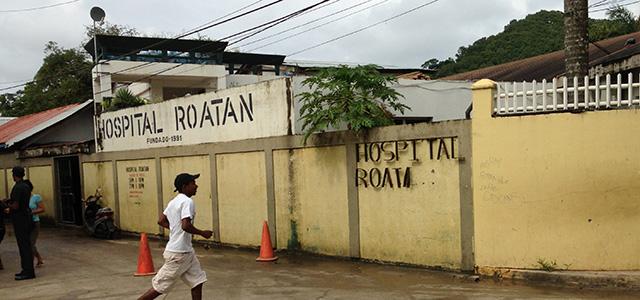
“Advancing Health Worldwide” in Roatán
A few miles from the resorts of Roatán – the largest in a group of islands off the coast of Honduras – the Public Hospital Roatán (PHR) is charged with delivering emergency, maternal and pediatric care for Roatán’s year-round residents. But as with far too many hospitals in developing countries, PHR and its dedicated staff have limited resources to battle a litany of disease, disaster and birth-related problems.
“Kids die of starvation, malaria, HIV and TB,” says UC San Francisco School of Nursing faculty member Mary Lynch. “It’s a classic example of health care disparities.”
Lynch and faculty and students from UCSF schools of dentistry, medicine, nursing and pharmacy and Global Health Sciences are collaborating with a Berkeley-based nongovernmental organization (NGO) called Global Healing and PHR to see if they can help shrink these disparities.
The Right Place, the Right Time
It was in 2001 that two specialty pediatric physicians affiliated with UCSF – pediatric intensivist Arup Roy-Burman and his wife, pediatric neurologist Sheila Jenkins – decided to take a year off to travel and recharge their batteries before resuming their careers.
“We also saw this as a chance to scout for a global health project where we could make a lasting impact, while also developing opportunities for other trainees in pediatrics,” says Roy-Burman.
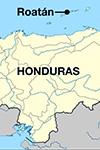 After exploring options in Asia and Latin America, they decided that Roatán seemed the perfect combination of manageable size, accessible distance and easy direct flights from the US. “Also, most everyone spoke either Spanish or English, which was right in the wheelhouse of UCSF trainees,” says Roy-Burman.
After exploring options in Asia and Latin America, they decided that Roatán seemed the perfect combination of manageable size, accessible distance and easy direct flights from the US. “Also, most everyone spoke either Spanish or English, which was right in the wheelhouse of UCSF trainees,” says Roy-Burman.
He and Jenkins made a connection with a local dive master who introduced the couple to health care and political leaders in Roatán. Soon after, Roy-Burman and Jenkins drafted an initial plan, which they presented to the Global Healing board on their return to the US. By 2003 the Roatán Volunteer Pediatric Clinic – staffed by volunteer attending physicians from the US – was seeing its first patients.
Within the next two years, a year-round elective for US residents was in place, with Global Healing administering the program, paying for the attendings’ airfare and providing both attendings and residents with housing. Next came the creation of a “fellowship” program in pediatrics for Honduran physicians, which ultimately has led to the hiring of a local physician to run the clinic year-round.
“Shortly after, we also started sending undergraduate student interns to Roatán in a nonclinical capacity,” says Luke Ifland, president of Global Healing. Titled Health Education & Advocacy Liaisons (HEAL), the program typically has students – usually premed or public health students who speak Spanish – serving as support staff for the clinic. They register patients, schedule follow-ups, arrange referrals and function as interpreters for providers not as fluent in Spanish.
The collaborative also rounds in the hospital in coordination with PHR’s newborn services and, more recently, is collaborating with the San Francisco-based NGO Medic Mobile on mHealth projects aimed at both improving internal nursing capabilities and extending resources and expertise beyond the hospital’s walls.
“Through all of this, we’ve had to earn and retain Roatán’s trust,” says Roy-Burman. “The people there don’t want students ‘practicing’ on them or expired medicines, and they’ve seen other NGOs come and go. But we’ve been there for over 10 years now, and they know Global Healing and now know UCSF.”
“The Ministry of Health loves having UCSF as a presence in the islands, and we’ve always been very happy with volunteers from UCSF. They’re not just high caliber, but they roll up their sleeves and are very realistic,” says Ifland.
In 2011 Roy-Burman moved full-time to UCSF and saw an opportunity to expand the Roatán effort again. “With the support of my division chief and chair, I approached our global health leadership about engaging all the schools at UCSF in Roatán. Our first traction was with Mary Lynch,” he says.
Nursing Steps Up
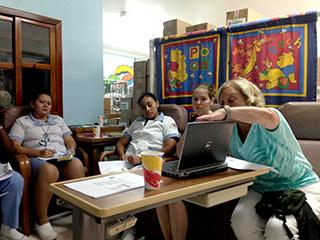 Since January 2013, Lynch has made three trips to Roatán and has been able to bring global health nursing scholar students with her to assess the needs of the nursing staff there and begin providing educational interventions.
Since January 2013, Lynch has made three trips to Roatán and has been able to bring global health nursing scholar students with her to assess the needs of the nursing staff there and begin providing educational interventions.
At PHR, nurses with one year of training and one year of clinical practice, called licencias, deliver the bulk of the bedside nursing care. “Though there are about 15 bachelor’s-prepared nurses at PHR, they’re mostly in administrative positions, and the conditions are such that many pursue options for working elsewhere,” says Lynch. “The licencias do the best they can with the resources they have, but we’re hoping education can help them do much more.”
“Nursing is an opportunity for the biggest return on investment,” says Ifland. “They’re delivering so much of the care but also receive the least amount of education and least attention.… This is common in the developing world, and a project like this is really empowering and motivating the nurses.”
Lynch’s plan was to provide innovative, resource-efficient learning opportunities rather than the traditional in-person classes. The Roatán nurses have told her it would be most helpful to have short videos to learn from, which would also help them better educate the families they work with.
“The nurses seem really intrigued with things like watching the resuscitation of a baby in a video clip on a phone,” says Lynch. “But it’s a big leap from being intrigued to watching something enough for it to improve practice – and to making sure anything we do will be taken over by health care teams in the hospital; that’s our commitment.”
That’s why, she says, it’s important that the videos reflect Roatán families and Roatán nurses doing the teaching at PHR, rather than using existing, more generic videos that do not speak to the distinct culture and setting. In addition, Lynch and her team expect to establish a program where the nurses would view the video clips three to five times over a two-week period and then take a post-test. Then the School will document changes in actual practice.
When she has secured funding, Lynch expects to work with Medic Mobile to create the videos and delivery system. The initial few will be aimed at improving practice around medication administration and helping nurses recognize and triage children in respiratory distress. Both emerged as clear priorities in the initial visits because of their impact on patient safety, which speaks to the students’ role in the Roatán engagement.
“The students were invaluable eyes in Roatán,” says Lynch. “They shadowed the nurses there, asked questions, and that’s how they came up with the concerns about medication administration and ways to address it. That’s an amazing educational opportunity – to apply your learning in real time in a developing country.”
A Link to Pharmacy
Lynch adds that the nurses’ initial focus on addressing medication administration has a clear link to medication supply chain concerns that the School of Pharmacy is examining. She hopes that, perhaps, they can secure funding as a linked program.
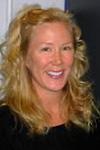 Tina Brock is the faculty representative from the School of Pharmacy. At first she was hesitant about the project, because most of her global health work has been in sub-Saharan Africa and she had not yet been to Roatán. But she was convinced by the enthusiasm of her colleagues from the other schools, the concerns they expressed about the medicine supply chain – and by her ability to connect via video chats with the pharmacy residents who would be going there. In the fall of 2013, pharmacy residents Navaneeth Narayanan and Sylvia Stoffella went to Roatán for a month.
Tina Brock is the faculty representative from the School of Pharmacy. At first she was hesitant about the project, because most of her global health work has been in sub-Saharan Africa and she had not yet been to Roatán. But she was convinced by the enthusiasm of her colleagues from the other schools, the concerns they expressed about the medicine supply chain – and by her ability to connect via video chats with the pharmacy residents who would be going there. In the fall of 2013, pharmacy residents Navaneeth Narayanan and Sylvia Stoffella went to Roatán for a month.
Their charge was to build on what was working in Roatán while figuring out what exactly was causing the supply chain problems. “You don’t want to solve the wrong problem,” says Brock, whose global health work includes other efforts to tailor realistic pharmacy solutions to existing conditions in developing countries. “In Roatán, our residents found that people struggle first of all with knowing exactly what they have in stock, so Sylvia and Nav worked closely with them to come up with a spreadsheet inventory.”
The education of the PHR pharmacy technicians – there is no pharmacist at PHR – was another factor. Despite their best efforts, they didn’t always know how to substitute equivalent medications for what the physicians were ordering if the exact order was not in stock. Another problem was limited space to archive and inventory medicines, which was sometimes complicated by well-meaning people donating drugs that were often close to expiration or not geared to the diseases the people of Roatán are battling.
Narayanan and Stoffella focused on building relationships and then helping the pharmacy staff strategize about short-term and longer-term interventions. “Ultimately, for example, the hospital would like to come up with standard treatment guidelines across the professions for the most common conditions they treat – guidelines that are linked to local needs and capacity,” says Brock.
As with nursing, Brock says the UCSF pharmacy residents take back as much as they give. “US pharmacists learn very little about supply chain management, but there are occasionally stockouts here and manufacturing shortages. Learning the processes and systems in Honduras made [the residents] more aware of the importance of these systems.”
Validating Varnishing
The projects in oral health care began in 2006, when Global Healing worked with Karen Sokal-Gutierrez from the UC Berkeley School of Public Health and former Global Healing Roatán Medical Director Howard Gruber of the UC Berkeley-UC San Francisco Joint Medical Program to develop and pilot a fluoride varnish project. (Gruber’s wife, Alice, a nurse, was the volunteer coordinator for the Roatán program until recently.)
“The immunization program is a strength in Roatán, and Honduras in general. Karen and Howard saw an opportunity to use the vaccination nurses to administer fluoride varnish in the course of traditional immunizations,” says Roy-Burman.
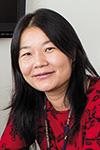 The impetus was the known connection among oral health, malnutrition and growth and development – as well as the prevalence of early childhood caries in Roatán and much of the developing world. According to Ling Zhan from the UCSF School of Dentistry, a 2012 screening in Roatán found a caries prevalence of over 71 percent for first-graders and 93 percent for second-graders. She says other studies have shown that early-childhood caries and its complications are preventable with simple, low-cost programs. And studies in the US have shown that varnish treatment prevents caries, but it was unclear how it would work with nurses trying to administer the treatment in the midst of a busy drop-in immunization clinic.
The impetus was the known connection among oral health, malnutrition and growth and development – as well as the prevalence of early childhood caries in Roatán and much of the developing world. According to Ling Zhan from the UCSF School of Dentistry, a 2012 screening in Roatán found a caries prevalence of over 71 percent for first-graders and 93 percent for second-graders. She says other studies have shown that early-childhood caries and its complications are preventable with simple, low-cost programs. And studies in the US have shown that varnish treatment prevents caries, but it was unclear how it would work with nurses trying to administer the treatment in the midst of a busy drop-in immunization clinic.
The fluoride varnish project seemed successful and garnered a lot of interest from the Honduras Ministry of Health for implementation on the mainland, but without documentation and analysis of the results, it was difficult to know whether and how to implement the program more broadly.
Ultimately, that’s where the UCSF School of Dentistry got engaged, first through then Associate Dean for Global Oral Health John Greenspan and now through Zhan.
“Using fluoride varnish through vaccination clinics in developing countries was a novel concept when the program was established in 2009, and our goal is to evaluate the implementation process and effectiveness of the program so we can make scientifically based recommendations to build a more sustainable project,” says Zhan.
She adds that the World Health Organization (WHO) is working on setting up studies to evaluate the concept in Latin American countries. “The results of our study will provide some pioneer data for this approach,” she says.
Zhan has a host of questions she has begun exploring in three visits to Roatán with pediatric dental residents. How effective is the current program? Is the approach sustainable? What is the acceptance level among caregivers, patients and families? Is there more that can be done to prevent the primary causes of tooth decay? (Lynch, for example, is interested in what nurses can do to educate mothers about nutrition and the advantages of breastfeeding.)
To get at those answers, Zhan’s team has interviewed and examined approximately 250 children, 56 of whom had the fluoride varnish treatment. They also collected medical health data to draw the connection between oral health, nutrition status and growth and development, as well as information about parents’ oral health knowledge and feeding behaviors to help determine the primary causes of tooth decay on the island.
Zhan presented the work at the 2014 UC Berkeley-UCSF Global Children’s Oral Health & Nutrition Symposium, which representatives from WHO attended. She hopes that she can coordinate efforts with WHO, which is developing oral health recommendations for the developing world. “This has the potential to be of use in other developing countries,” says Zhan.
Extending the Collaboration
Extending the work and continuing to take advantage of the partnerships that have grown in Roatán are on the minds of many of the participants.
Ifland believes the collaborations are starting to positively affect the health care culture, not just in Roatán, but also in mainland Honduras. “You can see some of the professional silos break down and the culture beginning to change to a real focus on preventive care that will improve the lives of everyone in Honduras,” he says. “We have every single thing in place there – the needs identified, the relationships, the experts, the program plans and the will.… Now we just need the funding, because the potential here is amazing.”
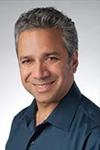 Roy-Burman agrees and believes the work in Roatán is having an effect far beyond the island, including in the clinical environment at UCSF. “The work there gets us out of our established silos,” he says. “In the US, our professions come together at the bedside, but our scopes are separate and distinct. In Roatán, we are much more apt to cross these traditional boundaries and start thinking like each other to develop truly transdisciplinary solutions. My partnerships with Mary in Roatán, for example, have spilled over here at UCSF into how we have integrated NPs into the Division of Critical Care.”
Roy-Burman agrees and believes the work in Roatán is having an effect far beyond the island, including in the clinical environment at UCSF. “The work there gets us out of our established silos,” he says. “In the US, our professions come together at the bedside, but our scopes are separate and distinct. In Roatán, we are much more apt to cross these traditional boundaries and start thinking like each other to develop truly transdisciplinary solutions. My partnerships with Mary in Roatán, for example, have spilled over here at UCSF into how we have integrated NPs into the Division of Critical Care.”
He also believes that Roatán may become a place others will look to as one important model for understanding how to engage in global health. Build a reservoir of trust by nurturing respectful partnerships with health services and public entities in the host country. Develop interdisciplinary programs that on the one hand improve the population health of the host and empower it to do more on its own, while on the other hand deepening the education of US faculty and students.
“Roatán may also be a real opportunity to take a clinical and humanitarian effort and leverage it with an academic effort – not just at UCSF, but with other UC campuses,” says Roy-Burman. “We can look at global health in a much broader, holistic sense, appreciating the complex relationships between biomedicine and the social, environmental and economic determinants of health. The moderate size and relative geographic isolation of the island renders Roatán a microcosm of global health challenges and an ideal location in which to prove scalable solutions applicable throughout the developing world.”
All of this work, however, demands more than an institutional commitment; it demands a personal commitment as well, says Lynch. “At this point in my career, I’m not looking for things that are going to bring me prestige, but instead I’m looking for things at the heart of nursing care,” she says. “This is what I want to do in my last 10 or 15 years of practice. This is part of why I became a nurse. This is why I am in Roatán.”

